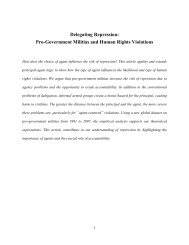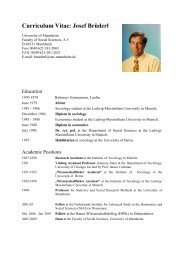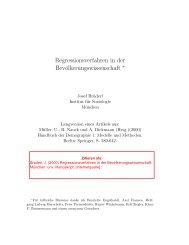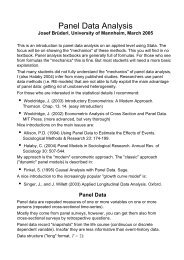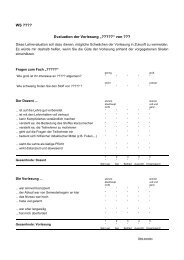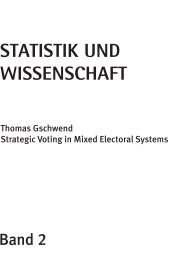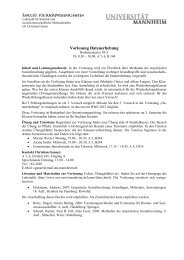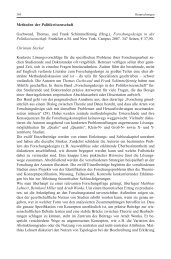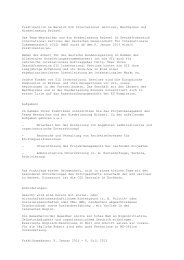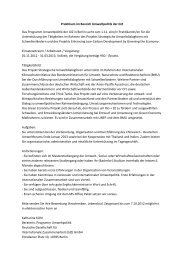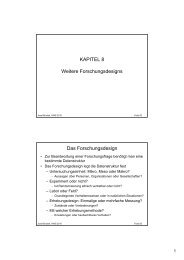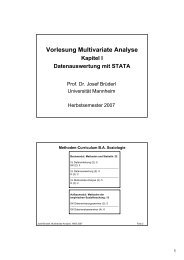An empirical test f the Ley-Sartori Conjecture
An empirical test f the Ley-Sartori Conjecture
An empirical test f the Ley-Sartori Conjecture
Create successful ePaper yourself
Turn your PDF publications into a flip-book with our unique Google optimized e-Paper software.
Comparative Politics of Strategic Voting:<br />
A Hierarchy of Electoral Systems ∗<br />
Thomas Gschwend<br />
Mannheimer Zentrum für Europäische Sozialforschung (MZES)<br />
University of Mannheim<br />
68131 Mannheim, Germany<br />
Thomas.Gschwend@mzes.uni-mannheim.de<br />
Abstract<br />
What is <strong>the</strong> impact of electoral rules on <strong>the</strong> way people make<br />
decisions in <strong>the</strong> voting booth? Institutional incentives moderate a<br />
voter’s expectation formation process and, <strong>the</strong>refore, make <strong>the</strong><br />
frequency of strategic voters predictable across a wide range of<br />
electoral systems. I provide evidence that <strong>the</strong>re is a latent dimension<br />
of propensity to cast a strategic vote following <strong>the</strong> wasted-vote logic<br />
on which various seat-allocation systems can be placed even<br />
controlling for district magnitude. Thus <strong>the</strong> variance of vote-to-seat<br />
conversion mechanisms is far more important in determining <strong>the</strong> level<br />
of strategic voting across electoral systems than previously thought.<br />
Paper presented at <strong>the</strong> annual meeting of <strong>the</strong> Midwest Political Science Association, April 20-23,<br />
2006, Chicago, IL.<br />
∗ I would like to thank Martin Elff, Kerstin Hönig, Mat Loveless, Susumu Shikano, Guy Whitten and Thomas<br />
Zittel for thoughtful comments on previous versions of this paper. Financial support from <strong>the</strong> Deutsche<br />
Forschungsgemeinschaft, SFB 504, at <strong>the</strong> University of Mannheim, is gratefully acknowledged.
Institutional Mechanisms and Strategic Voting<br />
What is <strong>the</strong> impact of electoral rules on <strong>the</strong> way people make decisions in <strong>the</strong> voting booth?<br />
The effect of electoral rules plays out in at least two stages. Scholars of electoral systems<br />
point to <strong>the</strong> impact of electoral rules on how votes are translated into legislative seats on<br />
election day. It is well-known (e.g. Hermens 1941, Key 1964) that <strong>the</strong> same distribution of<br />
votes can be translated in totally different distributions of seats in parliament using different<br />
electoral rules. If <strong>the</strong> outcome of an election is not just a foregone conclusion <strong>the</strong>n <strong>the</strong> effect<br />
of electoral rules might become a crucial determinant deciding who will be represented in<br />
parliament and who will govern. Preceding <strong>the</strong> vote-to-seat conversion stage, however, are <strong>the</strong><br />
processes of how voters make <strong>the</strong>ir vote choices given <strong>the</strong>ir preferences. Studying <strong>the</strong>se<br />
processes keeps motivating scholars of political behavior to get up every morning. While we<br />
have devoted so much time and know a great deal about <strong>the</strong> vote-to-seat conversion stage, we<br />
know less so about <strong>the</strong> influence of electoral rules at <strong>the</strong> preference-to-vote conversion stage.<br />
Electoral rules have an effect here if -- given <strong>the</strong> same set of preferences -- different electoral<br />
rules will lead voters to vote differently at <strong>the</strong> polls because voters try to avoid wasting <strong>the</strong>ir<br />
votes and vote strategically.<br />
How many voters actually compromise <strong>the</strong>ir preferences and vote strategically given<br />
particular electoral rules? So far <strong>the</strong> literature has merely developed hypo<strong>the</strong>ses about <strong>the</strong><br />
predictive implications of this for <strong>the</strong> number of parties competing in an election.<br />
Traditionally <strong>the</strong> literature makes prominent <strong>the</strong> size of <strong>the</strong> district magnitude as <strong>the</strong> prime<br />
shaper of strategic voting. I argue, however, that <strong>the</strong> role of <strong>the</strong> district magnitude in<br />
determining <strong>the</strong> frequency of strategic voting at <strong>the</strong> district level is grossly overstated. Instead<br />
I will lay out a rational on <strong>the</strong> individual level and provide evidence that electoral systems<br />
carry different levels of risk that voters might waste <strong>the</strong>ir votes. Therefore I develop a<br />
hierarchy of types of electoral systems ordered by an implicit continuum of risk to waste<br />
1
someone’s vote. This hierarchy predicts <strong>the</strong> level of strategic voting at <strong>the</strong> district level. The<br />
results based on individual-level data using <strong>the</strong> CSES module 1 indicate that <strong>the</strong>re is more<br />
meaningful variation in <strong>the</strong> level of strategic voting across electoral systems than previously<br />
thought and this variation cannot be merely attributed to incentives that get channeled through<br />
<strong>the</strong> district magnitude.<br />
A Comparative Look at Strategic Voting - Some Micro Foundations<br />
No matter whe<strong>the</strong>r you believe in Columbia, Michigan or <strong>the</strong> Rochester school of thought,<br />
traditional <strong>the</strong>ories of voting behavior have in common <strong>the</strong> prediction that voters should end-<br />
up casting a vote for <strong>the</strong>ir most preferred party (or candidate) 1 . This is called a sincere vote.<br />
Students of strategic voting point out that we never<strong>the</strong>less observe systematic deviations from<br />
<strong>the</strong>se traditional vote-choice predictions. In an attempt to model <strong>the</strong>se deviations <strong>the</strong>y suggest<br />
that voters do not merely take <strong>the</strong> utility into account that a voter derives from voting for her<br />
most preferred party but also <strong>the</strong> expectation about <strong>the</strong> outcome of <strong>the</strong> election, for instance<br />
whe<strong>the</strong>r her most preferred party is actually a viable alternative to win a seat in her primary<br />
electoral district (Blais et al 2001; Blais 2002; Cox 1997; Fisher 2004; Gschwend 2006). It is<br />
far from clear how voters actually form and weight <strong>the</strong>ir expectations against <strong>the</strong>ir<br />
preferences. Different voters might employ different decision rules. The particular approach I<br />
am following here is to assume for voters who turn out in <strong>the</strong> first place that <strong>the</strong>y vote for a<br />
party that maximizes <strong>the</strong>ir expected utility. Consequently, a strategic voter is someone who<br />
votes for ano<strong>the</strong>r party (or party candidate) than her most preferred one if <strong>the</strong> expected utility<br />
is higher than <strong>the</strong> expected utility from voting for her most preferred party. Strategic voting<br />
implies that voters form expectations, i.e., <strong>the</strong>y estimate probabilities, as to whe<strong>the</strong>r or not<br />
parties gain seats in a particular electoral district. If <strong>the</strong>ir most preferred party is expected to<br />
1 To simplify language I will just refer to political parties, even if voters can explicitly vote for<br />
candidates. Since I am looking at parliamentary elections, candidates are typically affiliated with a party list.<br />
2
gain a seat, voters cast a sincere vote. If <strong>the</strong>ir most preferred party is not expected to gain a<br />
seat, voters cast a strategic vote for <strong>the</strong> most preferred party among those parties who are<br />
expected to gain a seat. Thus, <strong>the</strong> more uncertain voters are, i.e. <strong>the</strong> lower <strong>the</strong> expected<br />
probability whe<strong>the</strong>r <strong>the</strong>ir most preferred party is able to win a seat, <strong>the</strong> more likely a strategic<br />
vote becomes.<br />
What factors determine <strong>the</strong>se expectations? Since voting behavior is no different from<br />
any o<strong>the</strong>r behavior in that it is not only situational but also dispositional determined I am<br />
going to distinguish between dispositional and situational criteria of how voters generate<br />
expectations about <strong>the</strong> probability that <strong>the</strong>ir vote is not wasted on her most preferred party.<br />
Electoral institutions pre-structure a voter’s decision situation. Situational criteria are<br />
determined by those specific institutional incentives that make <strong>the</strong> use of <strong>the</strong> wasted-vote<br />
strategy at <strong>the</strong> electoral district level a priori more or less likely. Dispositional criteria have to<br />
do with intrapersonal motivations and capabilities to comprehend <strong>the</strong>se situational criteria and<br />
how voters employ <strong>the</strong>m in <strong>the</strong>ir decision-making process. Moreover, <strong>the</strong>y have also to do<br />
with <strong>the</strong> use of appropriate decision heuristics provided by party elites or <strong>the</strong> media. For this<br />
paper, however, I take <strong>the</strong>se individual-level determinants as a starting point and try to predict<br />
<strong>the</strong> causal effects of situational criteria. I will argue that situational criteria systematically<br />
moderate a voter’s expectation formation process and, <strong>the</strong>refore, make predictable <strong>the</strong><br />
frequency of voters who employ <strong>the</strong> wasted-vote strategy across a wide range of seat<br />
allocation systems.<br />
Situational Criteria that undermine or enhance <strong>the</strong> Duvergerian logic in practice<br />
The <strong>Ley</strong>s-<strong>Sartori</strong> conjecture (Cox 1997; <strong>Ley</strong>s 1959; <strong>Sartori</strong> 1968) is <strong>the</strong> starting point of how<br />
situational criteria influence voters’ expectations whe<strong>the</strong>r or not a vote for <strong>the</strong>ir most<br />
preferred party is wasted. It posits that <strong>the</strong> higher <strong>the</strong> district magnitude, <strong>the</strong> less likely voters<br />
3
are to avoid wasting <strong>the</strong>ir vote for smaller parties and, hence, less strategic voting is expected<br />
to occur in that district. In order for this to work, <strong>the</strong> corollary at <strong>the</strong> individual level is that a<br />
voter’s expected probability that her vote is wasted should be smaller <strong>the</strong> larger <strong>the</strong> district<br />
magnitude gets.<br />
The predicted consequences about <strong>the</strong> frequency of strategic voting given that <strong>the</strong><br />
district magnitude varies have never been <strong>test</strong>ed comparatively. The notion of district<br />
magnitude according to <strong>Ley</strong>s (1959) and <strong>Sartori</strong> (1968) constitutes a universal characteristic,<br />
i.e., contextual effects do not matter. The hypo<strong>the</strong>sized causal effect of district magnitude on<br />
<strong>the</strong> frequency of strategic voting nei<strong>the</strong>r depends on a particular type of electoral or seat-<br />
allocation system nor is it a country-specific characteristic. It seems a bit simplistic to reduce<br />
all conceivable situational factors to be channeled through <strong>the</strong> size of <strong>the</strong> district magnitude.<br />
The electoral systems literature has meanwhile accumulated various institutional<br />
characteristics that possibly undermine (or streng<strong>the</strong>n) <strong>the</strong> wasted-vote logic. As a<br />
consequence more (or less) strategic voting should be observed at <strong>the</strong> electoral district level<br />
than o<strong>the</strong>rwise expected. Such characteristics are typically called “supradistrict factors”<br />
(Taagepera and Shugart, 1989: 112) because <strong>the</strong>y are sought to compensate or correct <strong>the</strong><br />
mechanical effect stemming from <strong>the</strong> size of <strong>the</strong> district magnitude.<br />
Consequently I will distinguish local seat-allocation (LSA) systems from supradistrict<br />
seat-allocation (SSA) systems. In local seat-allocation systems, seats are allocated only within<br />
<strong>the</strong> primary electoral district while in supradistrict seat-allocation systems, <strong>the</strong>re are additional<br />
situational criteria beyond <strong>the</strong> pure vote-to-seat convertion at <strong>the</strong> primary electoral district that<br />
define how seats are allocated. In terms of district magnitude two types of local seat-<br />
allocation systems can be distinguished: There are systems with varying district magnitude<br />
greater than one. I call <strong>the</strong>m multi-member district (MMD) systems. Consequently seat<br />
allocation systems in which every district has to elect one Member of Parliament are called<br />
single-member district (SMD) systems. Compared to <strong>the</strong> benchmark level of strategic voting<br />
4
set out by local seat-allocation systems, various situational factors are expected to diminish or<br />
enhance <strong>the</strong> incentives for voters to avoid wasting <strong>the</strong> vote and vote strategically. In<br />
supradistrict seat-allocation systems we should, <strong>the</strong>refore, expect <strong>the</strong> Duvergerian logic to<br />
operate differently. I will argue that <strong>the</strong> expected probability that a vote for <strong>the</strong> most preferred<br />
party is wasted (and <strong>the</strong>refore <strong>the</strong> risk to cast a strategic vote) does systematically differ at <strong>the</strong><br />
district level causing predictable patterns of strategic voting across types of seat allocation<br />
systems.<br />
In <strong>the</strong> following I will draw attention to four situational criteria that are presumably<br />
consequential for <strong>the</strong> expected probability that a vote for <strong>the</strong> most preferred party is wasted to<br />
differ and, <strong>the</strong>refore, determine <strong>the</strong> amount of strategic voting to occur at <strong>the</strong> district level: <strong>the</strong><br />
possibility of gaining compensatory seats, <strong>the</strong> existence of a national threshold to get<br />
representation, or <strong>the</strong> use of particular seat-allocation systems such as alternative vote and<br />
mixed electoral systems. 2 I will argue that <strong>the</strong> first three criteria undermine <strong>the</strong> Duvergerian<br />
logic while <strong>the</strong> incentives to vote strategically in <strong>the</strong> SMD tier of mixed systems will be<br />
streng<strong>the</strong>ned compared to what we would o<strong>the</strong>rwise expect in SMD districts.<br />
The first criteria is <strong>the</strong> possibility of an additional distribution of seats, so-called<br />
compensatory or remainder seats, that are based on regional or national party vote totals. The<br />
possibility, particularly for small parties to gain additional seats in secondary electoral<br />
districts on <strong>the</strong> regional or national level, clearly undermines <strong>the</strong> wasted-vote logic if some<br />
version of a PR rule is used. The expected probability that a small party might gain<br />
representation is perceived to be higher because a vote might not be wasted after all if <strong>the</strong>re is<br />
ano<strong>the</strong>r distribution of seats that helps to garner compensatory or remainder seats for such a<br />
party. A good example for an electoral system with an additional seats allocation at <strong>the</strong><br />
2 There are fur<strong>the</strong>r situational criteria that undermine <strong>the</strong> wasted-vote logic – at least <strong>the</strong>oretically. Voters might<br />
get motivated to waste <strong>the</strong>ir votes through provisions that entail even parties that fail to gain representation with<br />
additional bonuses short of representation, like blackmail potential (e.g. run-off elections in Hungary), financial<br />
reimbursement of campaign costs (e.g. in Germany) or rules of ranking <strong>the</strong> party (higher) on <strong>the</strong> ballot for <strong>the</strong><br />
next election (e.g. in Chile). However, <strong>the</strong> impact of <strong>the</strong>se situational criteria is presumably too small to be<br />
examined systematically within <strong>the</strong> confines of conventional survey research.<br />
5
egional level is Belgium (although this characteristic was abandoned for <strong>the</strong> la<strong>test</strong> election in<br />
2003). After a first distribution of seats in primary electoral districts, any remaining seats are<br />
allocated within secondary districts that are comprised of <strong>the</strong> Belgian provinces (Cox 1997:<br />
48-49, Fitzmaurice 1996: 96-99). I will call such systems adjusted multi-member district<br />
(adjusted MMD) systems.<br />
Second, <strong>the</strong>re are systems employing certain vote total preconditions that parties have<br />
to fulfill in order to participate in <strong>the</strong> seat allocation stage. The existence of a national<br />
threshold in multi-member district systems that parties have to surmount provides an<br />
incentive that undermines <strong>the</strong> wasted-vote logic. Sweden is a well-known example for an<br />
electoral system with such a situational criterion. To make this incentive transparent, take a<br />
small party supporter in a “pure” MMD system without a national threshold. Even in a large<br />
district she will try to avoid wasting her vote if she perceives <strong>the</strong> chances of her party to gain<br />
a seat as so low that <strong>the</strong> expected utility from voting for a different party that is expected to<br />
gain at least a seat is higher. Now suppose <strong>the</strong> electoral system employs a national threshold<br />
that has to be reached as a precondition in order to participate at <strong>the</strong> seat allocation stage. The<br />
very same supporter of this small party - even in a small district - will now expect that <strong>the</strong><br />
probability of her party to win any seats, although not in her local district, is much higher than<br />
before. Even in a small district a supporter of a small party might not waste her vote after all<br />
because every vote effectively helps <strong>the</strong> party towards reaching <strong>the</strong> preconditions to<br />
participate in <strong>the</strong> seat allocation stage and to be able to win a seat in ano<strong>the</strong>r primary district. 3<br />
National thresholds as preconditions lead voters to not expect <strong>the</strong>ir votes to be wasted on<br />
marginal parties according to this reasoning. Thus electoral systems with such a national vote<br />
total precondition provide essentially <strong>the</strong> same incentives undermining <strong>the</strong> wasted-vote logic<br />
3 There are <strong>the</strong> usual incentives to avoid wasting <strong>the</strong> vote on marginal parties, if <strong>the</strong> national level is <strong>the</strong> primary<br />
electoral district. Following <strong>the</strong> above logic <strong>the</strong>re are no fur<strong>the</strong>r ways to help a marginal party to gain additional<br />
seats. The higher <strong>the</strong> threshold is, presumably, <strong>the</strong> lower <strong>the</strong> expected probability that a marginal party might<br />
gain representation and, hence, <strong>the</strong> higher <strong>the</strong> voter’s proclivity to cast a strategic vote.<br />
6
as electoral systems that allow for <strong>the</strong> possibility to win compensatory seats. Therefore, I also<br />
call such electoral systems adjusted MMD systems.<br />
Third, if a country employs an alternative vote system, like Australia, small party<br />
supporters still have an incentive to rank <strong>the</strong>ir preferred party first even in a single-member<br />
district undermining <strong>the</strong> wasted-vote logic because <strong>the</strong>y always can rank a viable party<br />
second. If no party wins on <strong>the</strong> first count, <strong>the</strong>ir vote is not wasted for <strong>the</strong> second count. This<br />
logic is also similar to having a distribution of additional seats, since a vote might not be<br />
wasted if <strong>the</strong>re is a second distribution to allocate votes to reminding seats. Even if <strong>the</strong><br />
expectation is that <strong>the</strong>re is a winner on <strong>the</strong> first count, <strong>the</strong>re is still <strong>the</strong> potential to blackmail<br />
large parties. Thus, every vote for a small party is not simply wasted but enhances <strong>the</strong><br />
blackmailing power of such a party. Although <strong>the</strong>re are incentives to vote strategically even in<br />
such an electoral system, I expect that <strong>the</strong> incentives channeled through <strong>the</strong> district magnitude<br />
to be ra<strong>the</strong>r weak. Strategic voting in such a system does not only require information about<br />
voters’ first preferences as in multi-member systems but also about <strong>the</strong> distribution of voters’<br />
second and third preferences (Cox 1997: 92-95; Dummett, 1984: 210-230).<br />
The discussion of <strong>the</strong> previous three situational criteria shows that <strong>the</strong>re is reason to<br />
expect <strong>the</strong> existence of certain incentives that undermine <strong>the</strong> Duvergerian logic in practice.<br />
The forth situational criterion, however, provides an incentive to streng<strong>the</strong>n <strong>the</strong> Duvergerian<br />
logic - making it easier for voters to cast a strategic vote. Mixed electoral systems provide<br />
voters with a particular strategic environment because <strong>the</strong>se systems combine majoritarian<br />
and proportional representation principles. While in compensatory mixed systems (Germany<br />
and New Zealand), majoritarian and PR seat allocation systems are linked in order to let <strong>the</strong><br />
latter compensate for <strong>the</strong> disproportionality of <strong>the</strong> former. In non-compensatory systems<br />
(Hungary, Japan and Mexico), <strong>the</strong>re is no such seat linkage (Shugart and Wattenberg 2001).<br />
Even if one focuses only on <strong>the</strong> votes cast in <strong>the</strong> single-member districts because only <strong>the</strong>re<br />
we could expect <strong>the</strong> Duvergerian logic to operate at <strong>the</strong> district-level, <strong>the</strong> wasted-vote logic is<br />
7
obviously contaminated (Cox and Schoppa 2002, Ferrara and Herron 2005, Herron 2000: 61-<br />
64, Herron and Nishikawa, 2001, Gschwend et al. 2003) by <strong>the</strong> fact that even small parties<br />
field candidates and get SMD votes although <strong>the</strong>y have no chance of winning a seat. More<br />
importantly, however, because parties compete for votes at <strong>the</strong> same time on <strong>the</strong> PR tier at <strong>the</strong><br />
(provincial or) national level, voters are not likely to perceive <strong>the</strong> campaigns in both tiers<br />
independently. 4 Given how election campaigns enfold, <strong>the</strong> national-level and, hence, <strong>the</strong><br />
nature of <strong>the</strong> race for <strong>the</strong> PR seats is likely to be perceived more important than a SMD race,<br />
particularly in compensatory but also in non-compensatory mixed systems despite <strong>the</strong> “real”<br />
importance of electoral institutions. 5 Voters’ might change <strong>the</strong>ir critical referent from a party<br />
frame to a coalition frame, particularly if alternative coalition governments are identifiable<br />
before <strong>the</strong> election. This should facilitate strategic voting (Gschwend 2004). In order to<br />
enhance <strong>the</strong> chances of a majority for a preferred coalition, a strategic SMD vote of a small<br />
party supporter for a viable candidate of a coalition partner is not likely to produce strong<br />
cognitive dissonances in <strong>the</strong> first place. The utilities voters would derive from voting for<br />
parties that form <strong>the</strong>ir most-preferred coalition, presumably, do not differ much. We should be<br />
able to observe more strategic voting in <strong>the</strong> majoritarian tier of mixed electoral systems than<br />
o<strong>the</strong>rwise expected in SMD systems because <strong>the</strong> perceived costs of a strategic vote in <strong>the</strong><br />
4 Some voters might be able to form independent preference orders for <strong>the</strong>ir SMD as well as list vote race and<br />
simply vote for <strong>the</strong> most-preferred one among <strong>the</strong> viable candidates in <strong>the</strong> SMD race. There is no measure in <strong>the</strong><br />
CSES data to adequately control for this. For most voters, however, candidate and party preference orders are<br />
likely to depend on one ano<strong>the</strong>r. Following a party label heuristic (Gschwend 2004), voters could infer <strong>the</strong>ir<br />
candidate preferences simply from <strong>the</strong>ir party preference order. Thus, most often it does not make a difference.<br />
So when does it actually make a difference? Voters have to systematically desert <strong>the</strong>ir most preferred party and<br />
cast <strong>the</strong>ir vote for a local candidate that is expected to do better than <strong>the</strong> respective party candidate of <strong>the</strong>ir most<br />
preferred party – for no o<strong>the</strong>r than personal reasons. Although possible it is hard to imagine why mere personal<br />
characteristics (independent from <strong>the</strong> ones that explain partisan preferences) should be systematically higher for<br />
candidates of particular parties and systematically lower for o<strong>the</strong>r party candidates. Previous research identified<br />
<strong>the</strong> potential for personal votes to be particularly high in New Zealand and, particularly low in Germany (Blais et<br />
al. 2004; Gschwend 2004; Karp et al. 2002; Moser and Scheiner 2005; Pappi and Thurner 2002). No question:<br />
<strong>the</strong>re will be always personal votes. However, if personal votes in New Zealand were systematically behind <strong>the</strong><br />
observed frequencies of strategic voting potentially biasing <strong>the</strong> results of this paper, than we should find on<br />
average higher numbers <strong>the</strong>re than in Germany because <strong>the</strong> institutional context is <strong>the</strong> same. This is not <strong>the</strong> case,<br />
though.<br />
5 Given that <strong>the</strong> threshold a party has to overcome in mixed systems is pretty low, potential strategic voters<br />
following <strong>the</strong> Duvergerian logic on <strong>the</strong> list vote cannot systematically studied with <strong>the</strong> CSES data because voters<br />
are not asked to rate every party on <strong>the</strong> ballot. Typically <strong>the</strong> vote shares of parties one has voters’ preferences for<br />
are not threatened <strong>the</strong> threshold.<br />
8
SMD tier can be partly offset by a sincere vote for “her” party in <strong>the</strong> PR tier. Since <strong>the</strong> SMD<br />
vote in compensatory mixed systems is less important than in non-compensatory mixed<br />
systems, <strong>the</strong> perceived costs are probably even lower. For instance, in Germany a strategic<br />
SMD vote of a small party supporter does not harm <strong>the</strong> overall seat share in parliament for<br />
this party (Pappi and Thurner 2002, Klingemann and Wessels 2001). Thus, strategic SMD<br />
votes in compensatory mixed systems become essentially costless. 6<br />
Summing up, local seat allocation systems provide a benchmark following <strong>the</strong><br />
Duvergerian logic of how much strategic voting is expected at <strong>the</strong> electoral district-level<br />
particularly given <strong>the</strong> size of a particular district. Thus, I expect on average more strategic<br />
voting in SMD than in MMD systems (Hypo<strong>the</strong>sis 1). In supradistrict seat-allocation systems,<br />
situational criteria systematically undermine or enhance <strong>the</strong> Duvergerian logic in practice. If,<br />
on <strong>the</strong> one hand, seat allocation systems allow for <strong>the</strong> possibility to win seats above and<br />
beyond <strong>the</strong> ones allocated at <strong>the</strong> primary electoral district level as in adjusted multi-member<br />
district systems or permit to rank order preferences as in an alternative vote system, <strong>the</strong><br />
incentives for voters to follow a wasted-vote strategy are potentially diminished. Hence in<br />
such supradistrict seat allocation (i.e. in adjusted MMD and alternative vote) systems I expect<br />
to find on average less strategic voting of this type than in local seat-allocation (LSA) systems<br />
(Hypo<strong>the</strong>sis 2). These supradistrict factors might lead voters to expect that a vote for a<br />
marginal party might not be wasted after all. Given that one always can rank a viable party<br />
(candidate) second in alternative vote systems, I expect to find less strategic voting in<br />
alternative vote systems than in adjusted MMD systems (Hypo<strong>the</strong>sis 3).<br />
On <strong>the</strong> o<strong>the</strong>r hand, <strong>the</strong>re are supradistrict factors that motivate voters to think about<br />
viable government coalitions when casting <strong>the</strong>ir votes, for instance, when <strong>the</strong> translation of<br />
votes into seats is at least partially done by a PR seat-allocation system as in mixed electoral<br />
6 Fur<strong>the</strong>rmore, <strong>the</strong> Duvergerian logic is only one rational to deviate from <strong>the</strong>ir most preferred party. Electoral<br />
systems, where <strong>the</strong> focus is on <strong>the</strong> national level, provide additional incentives to vote strategically that do not<br />
get channeled through <strong>the</strong> district magnitude. Thus, a strategic vote in such systems can be <strong>the</strong> result of various<br />
strategies. It does not necessarily depend on <strong>the</strong> district magnitude alone and will be not considered here.<br />
9
systems. A strategic vote for a viable candidate of <strong>the</strong> coalition partner in <strong>the</strong> majoritarian tier<br />
is likely to produce fewer dissonances than in SMD systems without a second PR tier. Hence<br />
in <strong>the</strong> SMD tier of mixed electoral systems I expect to find on average more strategic voting<br />
following a wasted-vote strategy than in all o<strong>the</strong>r seat-allocation systems 7 (Hypo<strong>the</strong>sis 4).<br />
These supradistrict factors might lead voters to greatly reduce <strong>the</strong> costs that typically come<br />
along with casting a strategic vote – more so in compensatory than in non-compensatory<br />
mixed systems (Hypo<strong>the</strong>sis 5). Consequently, hypo<strong>the</strong>ses 1 to 5 yield a hierarchy of expected<br />
frequencies of strategic voters trying to avoid wasting <strong>the</strong>ir votes at <strong>the</strong> district level that are<br />
associated with various seat allocation systems. The expected hierarchy is summarized in<br />
panel (a) of figure 1.<br />
[Figure 1 about here]<br />
Now, controlling for district magnitude (M) one can asses whe<strong>the</strong>r those estimated differences<br />
across types of electoral systems can be attributed to <strong>the</strong> hypo<strong>the</strong>sized situational criteria that<br />
undermine or facilitate <strong>the</strong> Duvergerian logic in practice. If those situational criteria haven an<br />
impact on voters expectation formation process than <strong>the</strong> predicted frequency of strategic<br />
voting should be consistent with <strong>the</strong> ranking presented in panel (b) when comparing electoral<br />
systems with <strong>the</strong> same district magnitude (M = 1). Moreover <strong>the</strong>re are two types of seat<br />
allocation systems with varying district magnitude (M>1), MMD and adjusted MMD systems.<br />
Given <strong>the</strong> hypo<strong>the</strong>sized workings of compensatory seats or national thresholds for an<br />
individual’s expectation formation process, <strong>the</strong> frequency of strategic voting following <strong>the</strong><br />
wasted vote logic should be on average higher in MMD systems of a given district magnitude<br />
than in a comparable district in adjusted MMD systems (Hypo<strong>the</strong>sis 6) as presented in panel<br />
(c). If those situational criteria, however, do not operate as expected above and beyond <strong>the</strong><br />
incentives that get channeled through <strong>the</strong> district magnitude, than -- after controlling for<br />
7 This should hold particularly for SMDs under any seat allocation system.<br />
10
district magnitude -- <strong>the</strong>re should be no systematic difference observable across electoral<br />
systems.<br />
Data and Measurement<br />
The <strong>Ley</strong>s-<strong>Sartori</strong> conjecture does not predict how much strategic voting we should expect in a<br />
primary electoral district with a given magnitude. It simply formulates a tendency that <strong>the</strong><br />
higher <strong>the</strong> district magnitude, <strong>the</strong> less likely voters are motivated to avoid wasting <strong>the</strong>ir vote<br />
and, <strong>the</strong>refore, <strong>the</strong> lower <strong>the</strong> frequency of strategic voting in that district. My argument is that<br />
in order to form expectations about <strong>the</strong> amount of strategic voting that is going on at <strong>the</strong><br />
primary electoral district we have to take <strong>the</strong> complexity provided through <strong>the</strong> institutional<br />
context more seriously. Instead of <strong>the</strong> district magnitude, as previous research has done, we<br />
must primarily take into account <strong>the</strong> variance of rules by which votes are translated into seats.<br />
This might be particularly important in order to predict <strong>the</strong> number of strategic voters in<br />
various electoral systems if <strong>the</strong> district magnitude is low.<br />
Typically, <strong>the</strong> significance of <strong>the</strong> <strong>Ley</strong>s-<strong>Sartori</strong> conjecture and more generally, <strong>the</strong><br />
significance of Duverger’s famous propositions are mainly discussed in <strong>the</strong> electoral systems<br />
literature in terms of its consequences for <strong>the</strong> (effective) number of parties that has to be<br />
expected given certain electoral institutions. Strategic voting following <strong>the</strong> Duvergerian logic<br />
-- to avoid wasting <strong>the</strong> vote -- is <strong>the</strong> hypo<strong>the</strong>sized mechanism at <strong>the</strong> individual level that<br />
explicates why only a few parties are viable in a given electoral district even if many more are<br />
competing for seats. Thus, contrary to <strong>the</strong> literature about electoral systems this study does<br />
not merely focus on <strong>the</strong> consequences of strategic voting but tries to address <strong>the</strong> incentives<br />
motivating a strategic vote more directly.<br />
Since, presumably, many features of electoral rules have an impact on <strong>the</strong> nature of <strong>the</strong><br />
district race and <strong>the</strong>refore on strategic voting, some studies in this literature looking more<br />
11
closely at strategic voting use district-level ra<strong>the</strong>r than national-level data (e.g. Cox 1997, Cox<br />
and Shugart 1996, Herron and Nishikawa, 2001). Never<strong>the</strong>less, employing district-level data<br />
is only an indirect way to assess an individual-level phenomenon like strategic voting. Heroic<br />
assumptions about voters’ preferences as well as <strong>the</strong> well-known problems of an ecological<br />
fallacy plague <strong>the</strong> process of making inferences based on such a research design. Moreover,<br />
different strategic voting patterns might even cancel out in <strong>the</strong> aggregate and are <strong>the</strong>refore lost<br />
from any analysis geared at this level of observation. Particularly relevant for studying<br />
strategic voting is that we are able to measure (sincere) preferences of a given respondent<br />
directly and compare <strong>the</strong>m to her stated voting behavior. This is a great advantage compared<br />
to all studies that look only at aggregated election results (Cox 1997, Monroe and Rose 2002)<br />
because one does not need to make any additional assumption about voters’ preferences in<br />
order to distinguish strategic voting from o<strong>the</strong>r voting behavior.<br />
The Comparative Study of Electoral Systems (CSES) project is an almost ideal data<br />
set to analyze <strong>the</strong>se questions. It is a cross-national project with election studies across<br />
countries with great variance of <strong>the</strong>ir electoral institutions that also provides comparable<br />
individual-level data. In each participant country’s election study, a common module of<br />
public opinion survey questions is included. These data contain among o<strong>the</strong>r things questions<br />
about turnout, vote choice as well as candidate and party evaluations. Moreover, systematic<br />
information about characteristics of <strong>the</strong> primary electoral districts as well as <strong>the</strong> electoral<br />
system at large is merged to <strong>the</strong> individual data. Thus, <strong>the</strong> CSES data is especially suitable to<br />
study <strong>the</strong> effects of electoral institutions on citizens’ attitudes and behavior since <strong>the</strong> electoral<br />
systems of <strong>the</strong> participating countries do vary considerably. 8<br />
The comparative literature about strategic voting and electoral systems traditionally<br />
speaks to <strong>the</strong> (primary electoral) district level. I will choose <strong>the</strong> same level of observation in<br />
8 I use <strong>the</strong> CSES module 1 that was released on August 4 th , 2003. To <strong>the</strong> best of my knowledge this is already by<br />
far <strong>the</strong> largest data set used in a single study to estimate strategic voting comparatively. After all <strong>the</strong> fixes I<br />
consider Module 1 (contrary to Module 2) now to be quite reliable. Module 1 represent a broad sample of<br />
electoral systems and, fortunately, <strong>the</strong> seat-allocation rules of <strong>the</strong> participating countries vary a great deal.<br />
12
order to assess <strong>the</strong> consequences of varying district magnitude on <strong>the</strong> frequency of strategic<br />
voting. The hypo<strong>the</strong>sized causal process of varying district magnitude in this literature (e.g.<br />
Cox 1997) should operate here. Thus, my dependent variable is <strong>the</strong> fraction of all voters per<br />
electoral district who cast a strategic vote. In order to construct this variable I need to derive<br />
voters’ preference rankings of parties that actually field lists or candidates in a particular<br />
primary district, i.e., after elite coordination took place that might have reduced <strong>the</strong> number of<br />
available options on <strong>the</strong> ballot. 9 Party preferences are measured by standard 10-point party<br />
like/dislike scales and ranked accordingly for each respondent. In mixed systems I take <strong>the</strong><br />
SMD vote as relevant vote choice for my research question since only in <strong>the</strong> majoritarian tier<br />
one expects an impact of <strong>the</strong> district magnitude. 10 According to my conceptualization, a<br />
strategic vote following <strong>the</strong> Duvergerian logic is a vote for a less preferred party if <strong>the</strong><br />
expected utility that this party gains at least a seat in <strong>the</strong>ir district is higher than <strong>the</strong> expected<br />
utility that <strong>the</strong>ir most preferred party does gain a seat in <strong>the</strong>ir district. Unfortunately, it cannot<br />
be directly assessed how individuals weigh <strong>the</strong>ir preferences against <strong>the</strong>ir expectations,<br />
particularly since in most countries <strong>the</strong> CSES module was administered as part of a post-<br />
election study. Consistent with prior research (e.g., Gschwend 2004; Karp et al. 2002: 8) I<br />
<strong>the</strong>refore assume that on average voters get it right, i.e., <strong>the</strong>y expect a party to gain a seat if<br />
<strong>the</strong> party actually ends up winning a seat <strong>the</strong> district.<br />
Consequently, my dependent variable is <strong>the</strong> proportion of respondents per electoral<br />
district who cast <strong>the</strong>ir vote for a less preferred party if that party is expected to win a seat<br />
while <strong>the</strong>ir most preferred party is not. This group of strategic voters is most likely to follow<br />
<strong>the</strong> Duvergerian logic to avoid wasting <strong>the</strong>ir vote. 11 The advantage to operationalize strategic<br />
9 This also accounts for <strong>the</strong> complications that even within <strong>the</strong> same country voters do not necessarily have <strong>the</strong><br />
same choice-set (Shikano 2003) – e.g., because of elite coordination – and that <strong>the</strong>ir vote choices might be menu<br />
dependent (Kedar 2005). If <strong>the</strong> workings of <strong>the</strong> <strong>Ley</strong>s-<strong>Sartori</strong> conjecture is merely a product of elite coordination,<br />
voters have not even <strong>the</strong> chance to vote for marginal parties since <strong>the</strong>y would not even con<strong>test</strong> <strong>the</strong> election.<br />
10 In order to do that I assume that party and candidate preferences coincide for voters who do not vote for <strong>the</strong><br />
candidate of <strong>the</strong>ir most preferred party but for a more viable candidate. See also footnote 4.<br />
11 If respondents most prefer two parties at <strong>the</strong> same time while one party is expected to gain a seat and <strong>the</strong> o<strong>the</strong>r<br />
party is not I will count such a vote for <strong>the</strong> party that is expected to gain a seat on Election Day as a strategic<br />
13
voting this way is that it disentangles strategic voters following a wasted-vote strategy from<br />
voting behavior that can be interpreted as a result of o<strong>the</strong>r strategies (Blais et al. 2004,<br />
Gschwend 2004). Thus <strong>the</strong> frequencies of strategic voting are not falsely magnified as if we<br />
would take, for instance, simply every deviation from someone’s most preferred party as a<br />
strategic vote. In order to construct a measure of which party gained seats in a given electoral<br />
district I had to compile this information separately from country specific data sources and<br />
merge it to <strong>the</strong> CSES data. 12 The group of non-strategic voters is comprised of all o<strong>the</strong>r<br />
voters, e.g., sincere voters or voters of a party that is on <strong>the</strong> ballot in a respective electoral<br />
district but not being evaluated on <strong>the</strong> corresponding party likes/dislikes scale.<br />
Table A1 in <strong>the</strong> appendix provides an overview about <strong>the</strong> resulting percentage of<br />
strategic voting per election study that passed a data consistency check. Thus, first, I had to<br />
delete countries without any parliamentary vote-choice variable (Belarus, Chile, Lithuania,<br />
Peru 2000) in <strong>the</strong> CSES data module, and where district level information (Taiwan, Korea,<br />
Russia, Ukraine and Thailand) is not yet available 13 . Second, although providing some face<br />
validity for my dependent variable, I deleted <strong>the</strong> data of both pure PR systems (Israel, <strong>the</strong><br />
Ne<strong>the</strong>rlands). As expected, in both countries <strong>the</strong>re are no strategic voters following <strong>the</strong><br />
wasted-vote logic and, hence, no variation that can be modeled.<br />
The key independent variable following Duverger, <strong>Ley</strong>s-<strong>Sartori</strong> and Cox is <strong>the</strong> district<br />
magnitude. How exactly can one describe <strong>the</strong> simple relationship between <strong>the</strong> district<br />
magnitude and <strong>the</strong> propensity that a voter considers voting strategically following <strong>the</strong> wasted-<br />
vote logic? So far no agreement about <strong>the</strong> correct functional form is reached. In <strong>the</strong><br />
comparative electoral system literature some scholars assume a simple linear relationship<br />
(e.g., Cox and Shugart, 1996; Cox 1997) while o<strong>the</strong>rs argue (Monroe and Rose, 2002;<br />
vote since not including expectations in <strong>the</strong>ir decision calculus could have resulted in a vote for a party with a<br />
lower expected utility.<br />
12<br />
This information is not part of <strong>the</strong> official CSES data but will be made available for download in addition to<br />
<strong>the</strong> replication data set.<br />
13<br />
Never<strong>the</strong>less I included data from <strong>the</strong> Spanish legislative election in 2000 although <strong>the</strong> percentages of strategic<br />
voting across <strong>the</strong>se districts seem to be ra<strong>the</strong>r low.<br />
14
Taagepera and Shugart, 1989) that this relationship has to be non-linear. I, again, tried both<br />
versions and since <strong>the</strong> results are not statistically distinguishable from one ano<strong>the</strong>r I report <strong>the</strong><br />
analysis with <strong>the</strong> district magnitude measured by <strong>the</strong> size of it.<br />
Frequency of Strategic Voting and Rules of Seat Allocation<br />
In order to take a look at <strong>the</strong> expected frequencies of strategic voting across various seat-<br />
allocation systems, I create a set of dummy variables, scoring one if <strong>the</strong> electoral district<br />
belongs to a country that employs a particular seat-allocation rule and zero o<strong>the</strong>rwise. Thus, I<br />
create a dummy for SMD systems (Canada, UK, USA), multi-member district systems (Hong<br />
Kong, Peru, Portugal, Spain, Switzerland) and adjusted multi-member district systems<br />
(Belgium, Czech Republic, Denmark, Island, Norway, Poland, Romania, Slovenia, Sweden),<br />
alternative vote systems (Australia) as well as for compensatory (Germany, New Zealand) and<br />
non-compensatory mixed systems (Hungary, Japan, Mexico) that are incorporated in <strong>the</strong><br />
CSES (module 1) data. 14<br />
Since <strong>the</strong> fraction of strategic voting per district is calculated over a different number of<br />
grouped individuals, I employ a generalized linear model (GLM) with a logit link to<br />
appropriately model this type of fractional response data while making sure that <strong>the</strong> model<br />
predictions are bounded between zero and one.<br />
To facilitate interpretation of <strong>the</strong> estimated coefficient for each type of seat allocation<br />
system and to compare <strong>the</strong> results with <strong>the</strong> summarized hypo<strong>the</strong>ses in figure 1, <strong>the</strong> GLM<br />
estimation results are presented graphically in figure 2 toge<strong>the</strong>r with <strong>the</strong>ir corresponding<br />
robust (Huber-White) 95% confidence intervals.<br />
[Figure 2 about here]<br />
14 Conceptually - in accordance with <strong>the</strong> comparative electoral system literature - I assume that <strong>the</strong> relevant<br />
processes that constrain a respondent’s behavior to cast a strategic vote at <strong>the</strong> electoral district-level are similar<br />
enough to be comparable across electoral districts (within a seat-allocation system).<br />
15
The estimation results show that <strong>the</strong>re is quite some variation of strategic voting across<br />
various seat-allocation systems. As hypo<strong>the</strong>sized we can expect to find most strategic voting<br />
at <strong>the</strong> SMD-tier of compensatory mixed systems (9.7%) followed by non-compensatory<br />
mixed systems (6.3%) and “pure” SMD systems (4.9%). The next systems, MMD (3% and<br />
AV (3.2%), are <strong>the</strong> only building blocks of this hierarchy, which cannot be statistically<br />
distinguished from one ano<strong>the</strong>r. The least amount of voters following <strong>the</strong> wasted-vote strategy<br />
can be found in adjusted MMD systems (1.4%). Consequently, with <strong>the</strong> exception of <strong>the</strong><br />
frequency of strategic voting in Australian districts (Australia being <strong>the</strong> only country that fits<br />
this category) <strong>the</strong> predicted hierarchy is consistent with <strong>the</strong> hypo<strong>the</strong>sized hierarchy of figure<br />
1(a).<br />
Moreover, we can compare <strong>the</strong> predicted level of strategic voting across various<br />
institutional settings as long as only one seat is allocated, i.e. when <strong>the</strong> effects of district<br />
magnitude are controlled for. Compared to <strong>the</strong> predicted ranking of electoral systems in figure<br />
1(b), <strong>the</strong> results are consistent with <strong>the</strong> hypo<strong>the</strong>sized effects of various situational criteria.<br />
Given particular institutional rules -- such as in alternative vote systems that allow voters to<br />
rank <strong>the</strong>ir options on <strong>the</strong> ballot -- that are expected to undermine <strong>the</strong> wasted-vote logic in<br />
practice we observe significantly less strategic voting compared to <strong>the</strong> baseline set out by<br />
SMD systems.<br />
When <strong>the</strong> translation of votes into seats are partially done by PR-tier as in mixed<br />
electoral systems, however, <strong>the</strong> results indicate that voters seem to have stronger incentives<br />
for strategic voting at <strong>the</strong> nominal vote in mixed electoral systems than in SMD systems.<br />
Presumably voters can still vote for <strong>the</strong>ir most preferred party on <strong>the</strong> PR tier in mixed<br />
electoral systems, and, given that expected coalition formations facilitate coordination on <strong>the</strong><br />
SMD tier, this makes casting strategic vote particular easy. This might be interpreted as<br />
ano<strong>the</strong>r piece of evidence for <strong>the</strong> existence of contamination or interaction effect. Apparently,<br />
16
at least in mixed electoral systems various seat-allocation rules influence one ano<strong>the</strong>r. Voters<br />
do not see <strong>the</strong>ir candidate and party vote as independent from one ano<strong>the</strong>r.<br />
The results fur<strong>the</strong>r indicate that <strong>the</strong> level of strategic voting is also significantly higher<br />
in compensatory than in non-compensatory mixed systems, presumably arising from <strong>the</strong> seat<br />
linkage with <strong>the</strong> election outcome in <strong>the</strong> second tier. Thus, in addition to <strong>the</strong> possibility of<br />
having a PR seat allocation tier, what seems to matter for <strong>the</strong> frequency of strategic voting is<br />
<strong>the</strong> mere existence of an institutional corrective that compensates for <strong>the</strong> disproportionality of<br />
<strong>the</strong> SMD tier seat allocation. It presumably does reduce <strong>the</strong> costs to cast a strategic vote<br />
particular when comparing compensatory mixed electoral systems with all o<strong>the</strong>r seat-<br />
allocation systems.<br />
The cumulative evidence brought to bear in <strong>test</strong>ing <strong>the</strong> first five hypo<strong>the</strong>ses does<br />
support <strong>the</strong> idea that <strong>the</strong>re is a latent dimension of propensity to cast a strategic vote following<br />
<strong>the</strong> wasted-vote logic on which various seat-allocation systems can be placed. Never<strong>the</strong>less,<br />
<strong>the</strong> impact of electoral institutions on how voters form expectations whe<strong>the</strong>r or not supporting<br />
a party at <strong>the</strong> polls and make <strong>the</strong>ir vote count ra<strong>the</strong>r than merely counted is at least twofold.<br />
Besides particular rules that define how exactly votes are translated into seats, <strong>the</strong> size of an<br />
electoral district, <strong>the</strong> district magnitude, channels incentives that systematically mediate<br />
voters’ expectation formation process. Up to this point nothing is said about <strong>the</strong> impact of <strong>the</strong><br />
district magnitude on <strong>the</strong> frequency of strategic voting. Therefore I will refine my estimation<br />
strategy in <strong>the</strong> next step. In addition to estimating intercepts that represent <strong>the</strong> predicted<br />
frequency of strategic voting of each type of seat allocation system (as in figure 2) I also<br />
estimate slope coefficients that represent <strong>the</strong> expected decrease of strategic voting depending<br />
on <strong>the</strong> size of <strong>the</strong> district magnitude within electoral districts of a given seat-allocation<br />
system. There are only two slopes to estimate since <strong>the</strong>re are only two types of seat-allocation<br />
systems where <strong>the</strong> district magnitude is not constant: MMD and adjusted MMD systems. To<br />
estimate a coefficient for each type of seat allocation system I exclude <strong>the</strong> constant. The GLM<br />
17
estimation results, toge<strong>the</strong>r with robust (Huber-White) standard errors and <strong>the</strong>ir corresponding<br />
95 % confidence intervals are summarized in table 1.<br />
[Table 1 about here]<br />
If <strong>the</strong>re were any systematic influence that gets channeled through <strong>the</strong> district magnitude, we<br />
would expect that this effect should show up precisely in <strong>the</strong>se seat-allocation systems where<br />
<strong>the</strong> district magnitude is not constant. Thus both intercept and slope coefficients of MMD and<br />
adjusted MMD systems are of particular interest. 15 The results demonstrate that for MMD<br />
systems <strong>the</strong> variation in district magnitude does not seem to matter much. For adjusted MMD<br />
systems we obtain quite <strong>the</strong> opposite result. The expected reduction of strategic voting does<br />
seem to depend on <strong>the</strong> district magnitude. Maybe <strong>the</strong>se non-findings for MMD systems are a<br />
consequence of party elite coordination. We know that party elites try to strategically<br />
coordinate <strong>the</strong>ir entry beforehand. This yields to a reduction of available options on <strong>the</strong> ballot.<br />
Successful elite coordination might more or less preempt strategic behavior of voters.<br />
Fur<strong>the</strong>rmore, such coordination on <strong>the</strong> elite level seems to be more likely in systems where<br />
<strong>the</strong> institutional consequences can be easier predicted such as in MMD systems as opposed to<br />
adjusted MMD systems. Thus elite coordination effects could explain that <strong>the</strong>re seems to be<br />
not district magnitude effect in MMD systems but in adjusted MMD systems.<br />
Finally, a more thorough <strong>test</strong> of hypo<strong>the</strong>sis 6 would be to compare <strong>the</strong> level of<br />
strategic voting between MMD and adjusted MMD systems in electoral districts of <strong>the</strong> same<br />
magnitude. Despite <strong>the</strong> differences of <strong>the</strong> system-specific constants, one might ask whe<strong>the</strong>r<br />
<strong>the</strong> predicted level of strategic voting of <strong>the</strong>se systems is still different even for electoral<br />
districts with a large magnitude? To provide evidence for <strong>the</strong> remaining hypo<strong>the</strong>sis I<br />
simulated <strong>the</strong> expected frequency of strategic voting depending on <strong>the</strong> size of <strong>the</strong> district<br />
15 The remaining coefficients are <strong>the</strong> very same from which <strong>the</strong> estimates of figure 1 are constructed applying <strong>the</strong><br />
inverse link function.<br />
18
magnitude based on <strong>the</strong> estimation results reported in table 1. Figure 3 summarizes <strong>the</strong>se<br />
simulations. The lower line represents <strong>the</strong> predicted level of strategic voting for electoral<br />
districts in adjusted MMD systems. The upper line consequently represents <strong>the</strong> corresponding<br />
predictions for electoral districts in “pure” MMD systems. Every simulation is accompanied<br />
with <strong>the</strong>ir 95 % confidence interval based on robust (Huber-White) standard errors.<br />
[Figure 3 about here]<br />
Since it is problematic to simulate hypo<strong>the</strong>tical scenarios that are too far away from<br />
<strong>the</strong> data I only predict <strong>the</strong> frequency of strategic voting following <strong>the</strong> wasted-vote strategy for<br />
districts with district magnitudes that are actually represented in <strong>the</strong> data. For <strong>the</strong>se<br />
predictions I used <strong>the</strong> coefficients of <strong>the</strong> above table. The range of <strong>the</strong> district magnitude of<br />
primary electoral districts is a bit wider for MMD systems than for adjusted MMD systems.<br />
Most importantly, though, this graph illustrates that even across <strong>the</strong> entire range of actual<br />
(observed) district magnitudes, <strong>the</strong> predicted frequency of strategic voting is higher in “pure”<br />
MMD than in adjusted MMD systems as hypo<strong>the</strong>sized. For districts with a district magnitude<br />
greater than 12 or, to put it differently, in about 15% of all districts within such seat-allocation<br />
systems, <strong>the</strong> confidence intervals between <strong>the</strong>se systems do not overlap.<br />
Conclusion<br />
The workings of electoral laws not only have profound and well-known consequences for<br />
party systems, <strong>the</strong> type of government, and <strong>the</strong> nature of representation in general. They also<br />
have an impact on <strong>the</strong> way people make decisions in <strong>the</strong> voting booth. Some voters anticipate<br />
<strong>the</strong> outcome of an election because <strong>the</strong>y form expectations about it and act accordingly. The<br />
ways <strong>the</strong>se expectations play out seem to differ systematically across various electoral<br />
19
systems. Thus, my general finding is that <strong>the</strong> impact of electoral systems is less universal<br />
across different contexts than we previously thought it is. This conclusion is echoed and also<br />
well supported by recent comparative work (e.g. Birch 2003). Never<strong>the</strong>less <strong>the</strong> challenges for<br />
a given polity stay <strong>the</strong> same: voters wasting <strong>the</strong>ir votes cannot determine <strong>the</strong> composition of<br />
parliament. The institutional mechanisms that make someone’s vote count ra<strong>the</strong>r than to be<br />
wasted might provide - but also potentially undermine – <strong>the</strong> legitimacy of <strong>the</strong> electoral<br />
process. The district magnitude is not <strong>the</strong> prime shaper of strategic voting; while <strong>the</strong> variances<br />
of vote-to-seat conversion mechanisms across electoral systems deserve more scrutiny in<br />
future research. The presented evidence suggests that voters systematically avoid wasting<br />
<strong>the</strong>ir votes depending on <strong>the</strong> incentives provided by a given seat-allocation system even in<br />
districts of <strong>the</strong> same magnitude.<br />
The expected frequency of strategic voting at <strong>the</strong> district level is related to <strong>the</strong> district<br />
magnitude in adjusted MMD systems but not across “pure” MMD systems. On <strong>the</strong> one hand it<br />
could be that one has to think more precisely about <strong>the</strong> effects of various thresholds on <strong>the</strong><br />
district, regional and national level that might systematically undermine <strong>the</strong> Duvergerian logic<br />
to avoid wasting a vote on a small party. On <strong>the</strong> o<strong>the</strong>r hand, not only voters but particularly<br />
political parties are also likely to adjust <strong>the</strong>ir behavior according to <strong>the</strong> incentives by <strong>the</strong><br />
electoral system and do not field candidates or a party list if <strong>the</strong>y are not likely to win at least<br />
one seat. This might already eliminate or pre-empt possible wasted-vote calculations on <strong>the</strong><br />
voters’ side and makes it particularly hard to find a significant effect for <strong>the</strong> district<br />
magnitude.<br />
Some voters compromise <strong>the</strong>ir preferences in order to make <strong>the</strong>ir votes count. This<br />
paper provides a hierarchy of electoral systems based on an implicit continuum of risk to<br />
waste a vote that helps to predict <strong>the</strong> share of strategic voters. The results of this study are<br />
clear: There is meaningful variation in <strong>the</strong> frequency of strategic voting following <strong>the</strong> wasted-<br />
vote strategy on <strong>the</strong> district level above and beyond <strong>the</strong> levels that can be attributed to<br />
20
incentives that get channeled through <strong>the</strong> district magnitude. For <strong>the</strong> SMD vote in<br />
compensatory mixed systems, one can expect <strong>the</strong> highest share of voters that follow <strong>the</strong><br />
wasted-vote strategy while <strong>the</strong>re are apparently almost no incentives for voters in an<br />
alternative vote system to deviate from <strong>the</strong>ir most preferred party in order to cast a vote for a<br />
party that is expected to do better at <strong>the</strong> polls. The simulated predictions for seat allocation<br />
systems where <strong>the</strong> district magnitude varies made transparent that in MMD systems one can<br />
expect on average more strategic voters following a wasted-vote strategy than in adjusted<br />
MMD systems of <strong>the</strong> same district magnitude. The difference in strategic voting increases<br />
with <strong>the</strong> size of <strong>the</strong> district.<br />
Since this study looks more closely at <strong>the</strong> individual-level consequences of<br />
institutional rules than previous work has done, <strong>the</strong> presented results might also inform o<strong>the</strong>r<br />
literatures that only deal indirectly with individual-level behavior while looking at aggregate<br />
level outcomes. Most prominently, relationships between <strong>the</strong> size of <strong>the</strong> district magnitude<br />
and <strong>the</strong> (effective) number of parties in a given polity might not travel as easy through<br />
different institutional contexts as <strong>the</strong> current literature on party and electoral systems suggests.<br />
Moreover, since <strong>the</strong> incentives that get channeled through <strong>the</strong> district magnitude are not<br />
constant across various seat allocation systems, electoral engineers might suddenly have a<br />
much greater toolbox at hand to fine-tune institutional systems to better fit socio-political<br />
realities.<br />
21
Appendix<br />
Table A1: Frequency of Strategic Voting averaged by Country<br />
System of Seat Allocation Country (Year)<br />
Frequency of<br />
Strategic Voting<br />
No. of Districts<br />
in <strong>An</strong>alysis<br />
Mixed System<br />
Germany (1998) 10.3 314<br />
(compensatory) New Zealand (1996) 10.5 65<br />
Mixed System<br />
Hungary (1998) 2.0 130<br />
(non-compensatory) Japan (1996) 6.2 143<br />
Mexico (2000) 4.6 52<br />
Mexico (1997) 11.1 96<br />
Alternative Vote System Australia (1996) 3.3 148<br />
Adjusted Multi-Member Belgium (1999) 1.1 20<br />
District (MMD) System Czech Republic (1996) 0.1 8<br />
Denmark (1998) 2.8 17<br />
Island (1999) 1.8 8<br />
Norway (1997) 1.2 19<br />
Poland (1997) 5.5 51<br />
Romania (1996) 3.3 39<br />
Slovenia (1996) 2.2 8<br />
Sweden (1998) 0.8 29<br />
Multi-Member District Hong Kong (2000) 0.5 5<br />
(MMD) System Hong Kong (1998) 5.2 5<br />
Peru (2001) 3.3 10<br />
Portugal (2002) 4.9 15<br />
Spain (2000) 0.7 46<br />
Spain (1996) 5.2 44<br />
Switzerland (1999) 3.2 22<br />
Single-Member District Canada (1997) 5.3 243<br />
(SMD) System UK (1998) 7.2 207<br />
USA (1996) 0.02 205<br />
N (total) 1949<br />
22
References<br />
Birch, Sarah. 2003. Electoral System and Political Transformation in Post-Communist<br />
Europe. New York: Palgrave.<br />
Blais, <strong>An</strong>dré. 2002. “Why Is There So Little Strategic Voting in Canadian Plurality Rule<br />
Elections?” Political Studies 50: 445-454.<br />
Blais, <strong>An</strong>dré, Peter Loewen, and Marc <strong>An</strong>dré Bodet. 2004. Strategic Voting? In Jack Vowles,<br />
Peter Aimer, Susan A. Banducci, Jeffrey A. Karp, and Raymond Miller, eds., Voters'<br />
Veto: The 2002 Election in New Zealand and <strong>the</strong> Consolidation of Minority<br />
Government, Auckland: Auckland University Press, pp. 68-84.<br />
Blais, <strong>An</strong>dré, Richard Nadeau, Elisabeth Gidengil, and Neil Nevitte. 2001. “Measuring<br />
Strategic Voting in Multiparty Plurality Elections.” Electoral Studies 20: 343-352.<br />
Blais, <strong>An</strong>dré, Robert Young, and Martin Turcotte. 2005. "Direct of Indirect? Assessing Two<br />
Approaches to <strong>the</strong> Measurement of Strategic Voting." Electoral Studies 24: 163-176.<br />
Cox, Gary W. 1997. Making Votes Count. Strategic Coordination in <strong>the</strong> World's Electoral<br />
Systems. Cambridge: Cambridge University Press.<br />
Cox, Gary W. 1999. "Electoral Rules and Electoral Coordination." American Review of<br />
Political Science 2: 145-61.<br />
Cox, Gary W., and Mat<strong>the</strong>w Soberg Shugart. 1996. "Strategic Voting Under Proportional<br />
Representation." Journal of Law, Economics, & Organization 12: 299-324.<br />
Cox, Karen E., and Leonard J. Schoppa. 2002. "Interaction Effects in Mixed-Member<br />
Electoral Systems." Comparative Political Studies 35: 1027-1053.<br />
Dummett, Michael. 1984. Voting Procedures. Oxford: Clarendon Press.<br />
Duverger, Maurice. 1954. Political Parties. New York: Wiley.<br />
Fisher, Stephen D. 2004. “Definition and Measurement of Tactical Voting: The Role of<br />
Rational Choice.” British Journal of Political Science 34: 152-166.<br />
Fitzmaurice, John. 1996. The Politics of Belgium. A Unique Federalism. London: Hurst &<br />
23
Company.<br />
Gschwend, Thomas. 2004. Strategic Voting in Mixed-Electoral Systems. Reutlingen: SFG-<br />
Elsevier.<br />
Gschwend, Thomas. 2006. "Ticket-Splitting and Strategic Voting under Mixed Electoral<br />
Rules: Evidence from Germany". European Journal of Political Research, forthcoming.<br />
Gschwend, Thomas, Ron Johnston, and Charles Pattie. 2003. ”Split-Ticket Patterns in Mixed-<br />
Member Proportional Election Systems: Estimates and <strong>An</strong>alyses of <strong>the</strong>ir Spatial<br />
Variation at <strong>the</strong> German Federal Election, 1998.” British Journal of Political Science<br />
33(1): 109-127.<br />
Ferrara, Federico and Erik S. Herron. 2005. “Going it Alone? Strategic Entry Under Mixed<br />
Electoral Rules” American Journal of Political Science 49(1): 16-31.<br />
Hermens, Ferdinand A. 1941. Democracy or <strong>An</strong>archy: A Study of Proportional<br />
Representation. Notre Dame: University of Notre Dame Press.<br />
Herron, Erik. S. 2000. Mixed Signals: Incentive Structures and Party Strategies in Mixed<br />
Electoral Systems. Unpublished doctoral dissertation, Michigan State University.<br />
Herron, Erik. S, and Misa Nishikawa. 2001. “Contamination effects and <strong>the</strong> number of parties<br />
in mixed-superposition electoral systems” Electoral Studies 20: 63-86.<br />
Jeffrey A. Karp, Jack Vowles, Susan A. Banducci, and Todd Donovan. 2002. "Strategic<br />
Voting, Party Activity, and Candidate Effects: Testing Explanations for Split Voting in<br />
New Zealand's New Mixed System" Electoral Studies 21: 1-22.<br />
Kedar, Orit. 2005. “When Moderate Voters Prefer Extreme Parties: Policy Balancing in<br />
Parliamentary Elections” American Political Science Review 99(2): 185-99.<br />
Key, Valdimer O. 1964. Politics, Parties, and Pressure Groups. 5.ed. New York: Crowell.<br />
Klingemann, Hans-Dieter, and Bernhard Wessels. 2001. “The Political Consequences of<br />
Germany’s Mixed-Member System: Personalization at <strong>the</strong> Grass Roots?” In Mat<strong>the</strong>w<br />
Soberg Shugart and Martin P. Wattenberg, eds., Mixed-Member Electoral Systems. The<br />
24
Best of Both Worlds?, Oxford: Oxford University Press, pp. 279-96.<br />
<strong>Ley</strong>s, Colin. 1959. “Models, Theories and <strong>the</strong> Theory of Political Parties.” Political Studies 7:<br />
127-46.<br />
Monroe, Burt L., and Amanda G. Rose. 2002. “Electoral Systems and Unimagined<br />
Consequences: Partisan Effects of Districted Proportional Representation” American<br />
Journal of Political Science 46: 67-89.<br />
Moser, Robert G., and Ethan Scheiner. 2005. “Strategic Ticket Splitting and <strong>the</strong> Personal<br />
Vote in Mixed-Member Electoral Systems.” Legislative Studies Quarterly 30(2): 259-<br />
76.<br />
Pappi, Franz Urban, and Paul W. Thurner. 2002. “Electoral Behavior in a Two-Vote-System:<br />
Incentives for Ticket Splitting in German Bundestag Elections” European Journal of<br />
Political Research 41: 207–32.<br />
<strong>Sartori</strong>, Giovanni. 1968. “Political Development and Political Engineering.” In John D.<br />
Montgomery and Albert O. Hirschman, eds., Public Policy. Cambridge: Cambridge<br />
University Press, pp. 261–98.<br />
Shikano, Susumu. 2003. “Construction of Choice Sets and its Influence on Voting Decision:<br />
Application of <strong>the</strong> Probabilistic Choice Set Model for Voter Choice under Two-Ballot<br />
System in Germany and Japan.” Paper presented at <strong>the</strong> ECPR joint sessions.<br />
Shugart, Mat<strong>the</strong>w Soberg, and Martin P. Wattenberg. 2001. “Mixed-Member Electoral<br />
Systems: A Definition and Typology” In Shugart, Mat<strong>the</strong>w Soberg, and Martin P.<br />
Wattenberg, eds., Mixed Member Electoral Systems. The Best of Both Worlds? Oxford:<br />
Oxford University Press, pp. 9-24.<br />
Taagepera, Rein, and Ma<strong>the</strong>w Soberg Shugart. 1989. Seats and Votes. The Effects and<br />
Determinants of Electoral Systems. New Haven: Yale University Press.<br />
25
Figure 1: A Hierarchy Predicting <strong>the</strong> Share of Strategic Voters following <strong>the</strong> Wasted-<br />
Frequency of Strategic Voting<br />
Vote Strategy across Seat-Allocation Systems.<br />
(a) average (b) M = 1 (c) M > 1<br />
• Mixed Systems<br />
(compensatory)<br />
• Mixed Systems<br />
(non-compensatory)<br />
• SMD<br />
• MMD<br />
• Adjusted MMD<br />
• Alternative Vote<br />
District Magnitude (M)<br />
• Mixed Systems<br />
(compensatory)<br />
• Mixed Systems<br />
(non-compensatory)<br />
• SMD<br />
• Alternative Vote<br />
• MMD<br />
• Adjusted MMD<br />
26
Figure 2: Estimated District-Level Frequency of Strategic Voting across<br />
Frequency of Strategic Voting [in %]<br />
12<br />
10<br />
8<br />
6<br />
4<br />
2<br />
0<br />
Systems of Seat Allocation<br />
AV adjusted MMD SMD non-comp.<br />
MMD<br />
Mixed<br />
comp.<br />
Mixed<br />
27
Table 1: Estimated Frequency of Strategic Voting across Systems of Seat<br />
Allocation conditional on District Magnitude<br />
Dependent Variable<br />
Probability of Strategic Voting<br />
Independent Variables Coef. Std. Err. 95% CI<br />
SMD -2.971 0.079 -3.125 -2.816<br />
MMD (intercept) -3.137 0.252 -3.631 -2.642<br />
MMD - District Magnitude (slope) -0.025 0.025 -0.074 0.024<br />
Adjusted MMD (intercept) -2.964 0.226 -3.408 -2.520<br />
Adjusted MMD - District Magnitude (slope) -0.119 0.022 -0.162 -0.076<br />
Alternative Vote -3.404 0.147 -3.693 -3.116<br />
Mixed (non-compensatory) -2.703 0.079 -2.857 -2.549<br />
Mixed (compensatory) -2.233 0.070 -2.370 -2.096<br />
N 1949<br />
Deviance 2475<br />
LSA<br />
SSA<br />
28
Figure 3: Estimated impact of <strong>the</strong> District Magnitude on <strong>the</strong> Frequency of Strategic<br />
Frequency of Strategic Voting [in %]<br />
8<br />
6<br />
4<br />
2<br />
0<br />
Voting for MMD and adjusted MMD systems<br />
MMD systems<br />
Adjusted MMD systems<br />
0 10 20 30 40 50<br />
District Magnitude<br />
29



